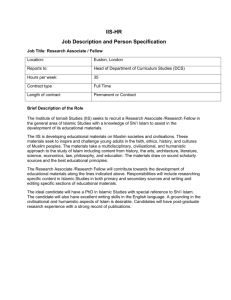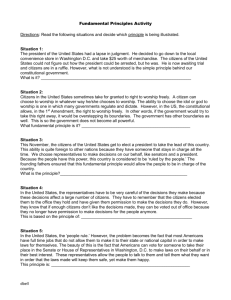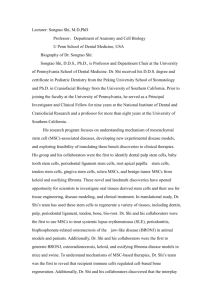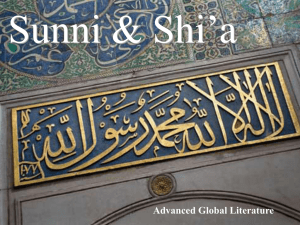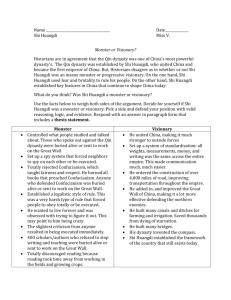Shattered Objects: artifact and icon in Islam
advertisement
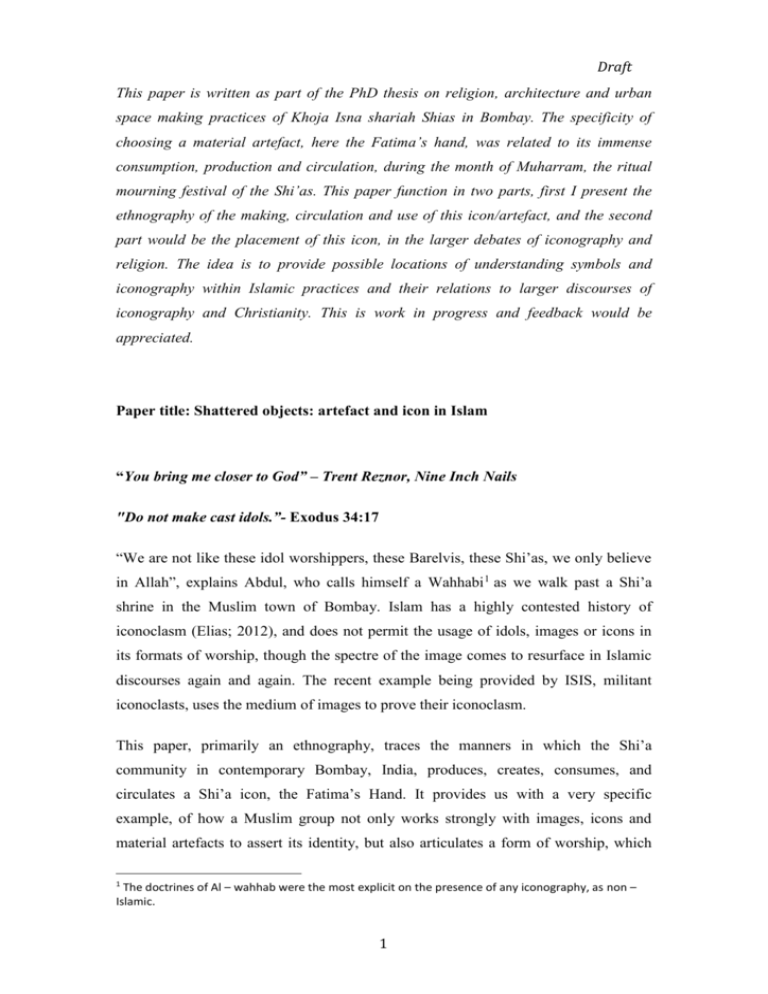
Draft This paper is written as part of the PhD thesis on religion, architecture and urban space making practices of Khoja Isna shariah Shias in Bombay. The specificity of choosing a material artefact, here the Fatima’s hand, was related to its immense consumption, production and circulation, during the month of Muharram, the ritual mourning festival of the Shi’as. This paper function in two parts, first I present the ethnography of the making, circulation and use of this icon/artefact, and the second part would be the placement of this icon, in the larger debates of iconography and religion. The idea is to provide possible locations of understanding symbols and iconography within Islamic practices and their relations to larger discourses of iconography and Christianity. This is work in progress and feedback would be appreciated. Paper title: Shattered objects: artefact and icon in Islam “You bring me closer to God” – Trent Reznor, Nine Inch Nails "Do not make cast idols.”- Exodus 34:17 “We are not like these idol worshippers, these Barelvis, these Shi’as, we only believe in Allah”, explains Abdul, who calls himself a Wahhabi 1 as we walk past a Shi’a shrine in the Muslim town of Bombay. Islam has a highly contested history of iconoclasm (Elias; 2012), and does not permit the usage of idols, images or icons in its formats of worship, though the spectre of the image comes to resurface in Islamic discourses again and again. The recent example being provided by ISIS, militant iconoclasts, uses the medium of images to prove their iconoclasm. This paper, primarily an ethnography, traces the manners in which the Shi’a community in contemporary Bombay, India, produces, creates, consumes, and circulates a Shi’a icon, the Fatima’s Hand. It provides us with a very specific example, of how a Muslim group not only works strongly with images, icons and material artefacts to assert its identity, but also articulates a form of worship, which 1 The doctrines of Al – wahhab were the most explicit on the presence of any iconography, as non – Islamic. 1 Draft does not entirely de-stabilise its location of being Muslim in a highly variant Muslim public sphere of India. Shi’a Muslims deploy a many forms for showing their veneration for the prophet’s family, ranging from sacred symbols, objects, texts, and somatic techniques, to enter into a relation of piety towards them. My paper is organized at around one Shi’a religious object, called the Panjatan, i.e.the Fatima’s hand. I trace here the manners in which it is created, circulated, and consumed in Shi’a religiosity and the everyday. Commemoration of Muharram, repetition of the stories of the Battle of Karbala, forms of self flagellation, use of particular colours, are all part of the cosmology of this icon, and provide it meaning. Subtracting itself from a sensibility of universalized abstractions of the idea of God in Islam, the Fatima’s hand works to make material, ideas of love2, commitment, kinship, veneration, worship and witnessing, as part of their religious practices. Their presence and materiality functions not just as mere substance, but also as an effect of power (Pels;2013), that shapes discourses of love, identity, history, worship and everyday life. Here the ethnography attempts to provide a piece-by-piece genealogy of this Icon, and how it emerges in different grids of specification (Foucault; 1977) of its existence and use. Laid out firstly by the artisan, who makes them, then for the people who worship and venerate it, and finally those who look towards at it in disdain, and as idol worship, the icon is constantly being made and remade through different metres of its existence. A metonymy comes to exist then between the iconoclastic aspects Islam, and the early the Calvinists who reduced all material artefacts of worship in the colonies to the fetish. The discourses entangle themselves in a very specific manner in the history of anthropology, visual studies, and art making it difficult to disengage from the epistemological positions our disciplinary practices come to offer. Background The early part of the history of Islam was fraught with succession wars, converging strongly at the fourth Caliph, Ali. Ali was the son-in-law of the Prophet, and chosen In Sufi literature, love has been classified in two main forms, namely, Ishq e Haqiqee, and Ishq e Majazee, namely, love of truth, or God/Allah, a more abstract idea of truth, and Ishq e Majazee, which relates to love in mortal, material forms. Both are important and one need to function within a dialectic of both to be able, live the life that is given (Schimmel; 1994) 2 2 Draft by the Prophet to lead the people, though eventually assassinated, and succeeded by the Umayyads under the leadership of Yazid. An intense succession battle occurs between the successors of Ali, and Yazid, at Karbala, leading to the single most important event of Shi’a history; the martyrdom of Hussein, the grandson of the Prophet. Though the division of Shi’s and Sunnis predates the battle of Karbala, the battle is seen by Shi’as as the single most important political and affective event, both historically and in the definition of what it means to be a Shi’a today. Every year, to commemorate the ‘martyrdom’ of the prophets family, Muharram is convened, across the world by Shi’as. A brief history of Shi’as and Muharram in Bombay The history of Shi’a sects in Bombay links to the rise of the city as an oceanic trade hub, in the early 19th century, where open markets, mercantile cosmopolitanism from across the world brought in different Muslim communities to the city. Nile Green, terms Bombay of this time as an Islamic Cosmopolis, which had Muslim traders coming and settling in from Yemen, Egypt, Iran, and Africa. Internal migrations mostly as labour and working classes, also joined this cosmopolis, brining in Shi’a and sunni cultures from Northern India. Green explains, this conjoining of mercantile classes, with the working classes, as one of the key factors in the in the commemoration of Muharram. Muharram commemorations were initiated in Bombay in the mid nineteenth century. The Mohalla had many forms of authority (Masellos; 2007), based on a combination of being from particular clans, merchant wealth, regions or the patronage of mosques or festivals, especially of Muharram. Muharram and practices associated with it, added to the density of the area. Large groups of people, differentiated on the basis of Shia sub sects, regions, mohallas or buildings, organised themselves into processions. The processions were based on specific material artefacts, namely the Tabuts (replicas of the graves of the Prophet’s family martyred at Karbala), Alams (black banners and symbols) with Panjas (a model of a hand, where the five fingers represent different members of the prophets family) that were strongly associated with being Shia’ in the public sphere. Each locality/sect/ or family dressed up its own Alam and Panja and manufactured its own Tabuts. The Muharram processions were a circulation of these artefacts across the area of Dongri, which came to marked with holy spots for this 3 Draft Ziyarat. Today spots such as the Mughal Masjid, the Khoja masjid, the Mehfil e Shah e Khurasan and the Zainabia hall, are all parts of this locally generated religious topography. ‘You put up an Alam or a Zari and put a money box under it, and their you have a shop open for collecting money’ Safar Ali and old Irani explains cynically the creation of the innumerable Ziyarat3 spots in Dongri. He recalls vaguely, one such spot near the JJ hospital, a block down from Dongri, where a man claimed that the Panja set up in his house, bled. Thousands of people began to turn up there, and the man became a rich man over night, he explains to be chuckling. Of course the presence of these spots linked to economic aspects in a thriving religious marketplace (Green; 2011), but it was also a manner of claiming the city, fraught with scarcity of space, property and land ownership disputes, extreme inequalities in economic status, dense religious sectarianism and competition between the Shi’as and the Muslims. Place making has always come to be associated with more acceptable forms of social legitimacy, than just undertaken in the form of economic reasons. The sudden presence of Acheiropoietas, usually mediated through dreams have been part of Hindu and Muslim cultural practices of generating sacred space 4 . The presence of such objects, in the case of shi’as usually in the form of impression of the foot of Ali, or the presence of a Panja, ties together tightly a material icon, through a dream to particular space5. The spots of ziyarat, related more closely to a history of evacuee properties, miracle-healing stories, trust disputes, getting resolved through dual-sharing of niaz (gifts and donations from people) from the Muharram collections between trusts or families. . Muharram also developed as a worker’s carnival (Green; 2011), organising large tolis of working class Muslims to participate and compete in activities of Tabut decorations 3 Ziyarat, technically translates as a visitation or a holy pilgrimage to a holy spot. It involves the idea of Darshan, to see and to be seen. People who visited spots across Dongri, for ziyarat, would read prayers to the alters of alams and panjas, or to the Zaris displayed in these spots. 4 I visited the shrine of Hazrat Abbas in Lucknow, to trace the forms of Panjas and Zaris in religious iconography for Shia’s. The story of this shrine related to a poor man, Mirza Beg, who was visited by Hazrat Abbas in his dream and directed to dig out his alam from a specific location in the city. Faqeera went to the site, and discovered a large bronze alam in the shape of a Panja. He placed it reverently in his house, the news of his discovery spread and people started visiting his place with offerings. Nawab Asaf-ud-Daulah eventually got a dome built over it and converted it into a shrine. 5 The acceptability of dreaming as a legitimate format for such rationalisations, connects back to the strong presence of ‘revelation’ of the Quran to the prophet. See also Ian Edger;1995 for dream work in Islam, Pandolfo; 1997, for Dream and space making. Corbin;1969, provides an elaborate discussion on the relationship between iconography, mediated through a creative imagination, and mediums such as light and dreams to notions of the ‘spiritual’ in Islam. 4 Draft and carrying, chest beating, blood-letting flagellations creating a very euphoric space. This heightened anxiety for the colonial administration, by the sheer number of people and tolis on the streets during those ten days. Also young men, undertaking intensive self-flagellation appeared to the austere sensibilities of the British administration, as a violent and pagan spectacle (Edwards; 1912). Even today in this area, the blood-letting flagellations of the tenth day, are seen as ‘jahaliyat’ by many non shi’s sects. Tabut processions created a lot of intra-sectarian violence and even riots (Kidambi; 2007), specifically between the Bohras6, and the Khoja Isna shairahs, who continued to engage in a public sphere format for Muharram observances. Tabut processions were eventually banned in 1907, S.M. Edwards, who had earlier tried tactics such as introducing Tabut licences, to limiting the number of licences issued, along with spatial management of routes for the processions of different groups, got rid of the whole thing. Today the most common artefact circulated during Muharram is the Panjatan, namely the Fatima’s hand, in the form of a Alam i.e. a flag post. The Shi’a Marketplace today The so called ‘Native town’ of Bombay houses the most important location for the commemoration of Muharram. Dongri a highly congested residential area and market place is the hub for all the activities predating Muharram and also the busiest marketplace for Shia’ paraphenelia. On a regular day, shops open by the late morning, to sell a range of things, related to Shia practices of worship, belief and ritual. Shops here have a versions of the Panjatan-pak (Fatima’s hand) in all sizes, as jewellery, as life size replicas, as smaller tokens, and as alters. Besides this the market has huge supplies of Turquoise (Firozeh) Red-chalcedony (Aqiq) in ring and other forms, since 6 The Bohras under the leadership of Syedna Mohammed Burhanuddin undertook many reforms for their group during the mid 19th century. One of these included the withdrawal of public space activities related to Muharram, which included the making and circulation of Tabuts and Alams, self flagellation rituals of blood letting and Ziyarat in the form of processions. It showed a sense of differential self making and presentation by Bohras, to the colonial public sphere, marking them as different from the other Shia’s and Muslim groups of the area. They instead congregated in exclusive community halls built only for the Bohras, and under a more silent commemoration in the forms of majlises run by religious leaders. 5 Draft the belief goes that Hazrat Ali used to wear these 7 . Pendants in turquoise of the panjatan, or swords, various kinds of strings and stones to be worn as amulets, knives, blades, permanent silver tabuts, panjas, black t-shirts, jhoolas, and many other things related to the story of Karbala and the prophets family are found and bought in this market place. These objects are bought by shias from across Bombay throughout the year with a special significance of the market arising in the month of Muhurrum. During Muhurram practices of azadari (ritual mourning), making and displaying of alams (flags with panjatan on them) and taziyas (replicas of the shrines) and of course ziyarat (visitation of the shrines of the of the family of the prophet.) are some of the ley activities these objects get deployed in. My fieldwork is located in this area, which houses innumerable shops selling the Fatima’s hand, artisan shops which produce them, and also the largest use and circulation of these here. Making: Panjatans8 as work and kinship The Fatima’s hand also known as the Panja, or Panjatan, is the most common artifact found here and is available in the form of flagposts (alams), amulets, alters, paintings, lockets, stickers etcetera. Shaped as a hand, made of copper, brass, silver, tin, steel or plastic, this artefact, represents the five most important people in Shi’a belief, namely the Prophet, Ali, Hasan, Hussain and Fatima. Besides Panjatans, other artefacts related to the story of Karbala are also found, such as replicas of mashaks (water carriers), prayer stones made with the mud of Karbala, cradle replicas (for Ali Asghar, the youngest martyr of the battle), Zuljenah(the horse of Karbala), Zaris’s (replicas of the graves of the prophets family swords, chains, whips, black flags, Dvd’s of songs, stories and books on the battle of Karbala, fill up every shop in this lane. The overwhelming presence of the Fatima’s hand in the shops, and a high customer demand for them, first leads me to study this artefact. I begin this exploration with the artefact with one artisan who grafts these in the same area, and supplies to a large 7 Colours such as turquoise blue, green, red and black are widely and commonly seen in the everyday life, religious practices and the marketplace of Dongri. They are deployed for religious practices (black for muhharam), community and sectarian markers (green flags for being Muslim, black flags for Shias), and as part of everyday practices of worship, luck, nazar, identity etcetera. The continuous presence and use of these colours by people presents to us one more template to understand the forms of religious practices. 8 Panjatan is the word used for the Fatima’s hand in my field work area. 6 Draft number of shops and Shi’a customers. “I am the tool in the hands of Allah, I am not making this, he is making me create these, and everything is in his image”, explains the oldest Panjatan/Alam maker in Dongri. “This is barkat, this skill, it’s all from the Ahl e Beit9”. Earlier I had met the a young boy, who also made Alams, he had told me,” even though I am a Sunni, this is what I have learnt from my father, the Panjatan have run my family for three generations now, so I believe in them”. I spend a lot of time at the small makeshift shops and workshops of the Alam makers, where I learn about the ways in which different materials work, their quality, cost, and abilities of malleability. The Artisan continuously moves between certain very universalizing, and abstract notions of god, selfhood, and what it means to be followers of the Shi’a Imams, and yet there is a banality to his everyday, rooted on design, costs, customers, skill, labour costs, and a persistence10 to sustain continuity in his income. He calls this sustenance, ‘barkat’ something which could be read as infinite gift given to him, as long as he continues to make the Panjatans, his barkat and his income continues11. Many customers come to the Alam makers, some want it done in silver, some in brass, since it’s cheaper. The whole conversation is based on the artefact, the panjatan, which could be in the form of a flag mast or just as small alter for the house. The people who buy it, have saved money for it, they place it in buildings as flag masts, or alters for Muharram congregations and ascribe it with their everyday prayers, the artisan too ascribes it with a different kind of everyday, that which is based on the continuity of his income, his ability to execute and to receive new orders from customers. The artisan’s explanations of his own identity and self are rooted on the fact that the he makes these Panjatans, but in return they also make him, as he submits his ability, skill and continuity to the power he draws from them. He moves smoothly between issues of design, malleability, of the metals used, to the controversies of what can be etched onto these hands shaped artefacts, especially what designs are in demand. “These days people want simple Panjatans, not with many Ahl e Bayt is the title given to the five holy ones in Shia Islam, namely, the Prophet, Fatima, Ali, Hussain and Hasan. 10 What do we do when we write?, we relate some of our ideas, to universals, or abstractions, words provide us the materiality, grammar gives us the measure and the aesthetics. All this is honed through ways in which writing is received, through its communicability, based on precision and clarity, which develops through and skill and repetition over time. 11 Mehta (1987) traces a similar relation in his book Work, Ritual and Biography, where he traces the life world of Muslim weavers in North India. They continuously create a relationship of the piety towards god, through their work, which is connected to their life world, through both semiotics and the actual act of weaving. 9 7 Draft flowers, they like just the names of the five pure ones on them” he explains one day, drawing me closer up to the issues of iconography and as they come to exist within Shi’a Islam. An incident, at the artisans shop, reaffirms the presence of this debate, within Shi’a thoughts and practices. “Please remove these tigers12, just melt them out, they are not needed, and put the ayats from the Quran here” when I ask them later, why they want this done on their Alam?, they explain. “This is a very old Alam, in our family for three generations, the problem is that our ancestors did not have ilm (knowledge) properly about Islam and they had got this made, we know this is not permitted in Islam, and hence we are getting them melted….” This incident, touches upon the fact that debates that surround the larger Shi’a/ Sunni debates on ideas of representation, are also as such present within the realm of shi’a practices. Finbarr Barry Flood, in his forthcoming book13 explains the tricks that were created within Islamic art, to be able to be within the fold of Islamic practices, which at some point in history did not permit the use of eyes and eventually live figures, including animals in it. Use of flowers and word(here texts from the Quran), then came to replace, and decorate, things, buildings, and books, replacing ‘live things’ such as human faces, and animals. In Islamic architecture too, the ornament, became, geometry, symmetry and text, pointing towards a ‘formless god’, and remaining within the permissible rules of representation in Islam. A famous Hadith, tells the story of how, Aisha, the prophet’s wife had built a tapestry, with images inter-sown into it, when the Prophet saw it, he wished that she would take it down. Aisha, takes it down and refashions them into cushions (Elias, 2012). The reason for the Prophet’s objection to it, was not one related to it having images, but rather the fact that it kept distracting him from the sight of God. It is this continuous, tension of pure abstraction and dispersal14 into forms that the debate on Tigers and Lions in Shi’a iconology come to represent Ali, who is considered the fearless one, the Ismailies and the Khoja isna Shariahs still use the tiger, in some of their posters, to represent Ali. 13 Figures as flowers: Altered Images in a Mughal Manuscript, talk on his forthcoming book, at Bombay, December, 2012. 14 The debate on the Universal and the particular can be traced all the way from Platonic ideas of idle types, to Jung’s archetypes. Within religious studies also, the debate is present in the Vedantin concepts, of monoism and dualism, in Islam, it appears in the ways in which Wahhabi Islam comes to only view everything through the frame of one Allah, while other schools organize themselves through, either belief in the Prophet (ahl e hadis), Shi’aism (the ahl e Bayt) or Sufism( veneration of valees, or the chosen ones). 12 8 Draft iconography, idolation, image, and worship comes to be based across many religious doctrines and practices. Continuity between the forms of abstraction, namely the force of the prophets family, and forms of particularization, creating the material object, gather smoothly at the level of the artisan. He suggests to us in his existence a double signification, accepting on one side the materiality of this object, and all that it gives him in terms of labour, craftsmanship, and an earning, and yet denying it simultaneously by locating all the skill, labour, work, craftsmanship as barkat, or as an endless gift from the Panjatans themselves. Shopkeepers selling, the Panjatans, embody a similar zone of work, where on one side they admit the running of their shops, as ‘barkat’ of the Panjatans, they function, as any other businessmen or shopkeepers do, keeping a diligent tab on costs and rarely offering discounts. The Panjatans artefact begins to go through other forms of sociality as Muharram descends onto Dongri. “Its like dressing up a bride” tells the young boy at the Raffiya sufi shrine, while he polishes the Panjatan Alams a few days before Muharram is to start. “You cannot show the neck, you have to use a Patkaa(a piece of cloth, usually velvet, colored red, green or black), otherwise its be-pardah (not veiled)”. Over the next few days, the whole area unfolds, in an array of large Panjatans being dressed and masted on bamboo poles, for the final days of Muharram. Gilded velvet, silk and cotton cloth, mostly in black, white or red, and sometimes splashed with imitation blood is draped onto the flag masts, with the Panjatans as the masts. Intensive accesorization through rose and jasmine garlands, replicas of chains, pots, swords, mashaks (water carriers), smaller Panjas, pearl necklaces, red threads begin to adorn the alams. One old man, stands dressing the Alam outside the main Shi’a mosque, has patiently been arranging long jasmine garlands, when I ask him, what he is doing? He explains “Sehra laga raha hoon” (I am putting the veil for the bridegroom). Using marriage tropes to connect with the martyrs of Karbala continues through Muharram, converging on the 7th day, where a henna ceremony, is performed in the name of Qasim, an 18 year old killed in the battle. The Panjatans at the most important Mehfil, have all been dressed up for ceremony for the henna ceremony for this young martyr. A young Zakira, explains me the story, “this is for Qasim, he dies in the battle, and his mother does not even get to do Mehandi for his marriage, we are doing this to make up for what she could not do” . On the day of the ceremony, some of the Panjatan alters are dressed with red cloth materials, adorned with jewellery, pearl necklaces, 9 Draft gold chains, and special garlands usually meant for marriage ceremonies. This ritual, drawing from traditions of Indian marriage ceremonies, has come to be found most prevalent amongst Indian Shi’as 15 rooting a transnational religion, into a localised cultural ethos. There is an enactment of an imagined scene, as the Panjatan alters bear witness. Large palates with henna, heaps of flowers, sweetmeats, lamps, fruits, and incense are carried around the room, along with songs being sung for the marriage of Qasim. Young girls take the lead in this ceremony, “as if it were for my brother” tells me one. They are singing songs, some are chest beating, and some are weeping. A common song at this ceremony exclaims “aason bahatee, nauhe sunatee, jannat se aayee qasim kee mehandee… (breaking into tears, singing dirges, the Hennah for Qasim has come from Heaven…)”. The song suggests, that the colour of the henna are provided in the spilling of his blood, and the martyrdom is his marriage. Ali Asghar a young Bohra Shi’a scholar, explains to me the strong links between Shi’a and Sufi eschatology’s regarding ideas of love and death. “For the Shi’as, the final marriage of valees is to god, and these our valees, the martyrs of Karbala, are the beloved of Allah, and hence they are asked to return to him, before their time is done in the world”, he elaborates. This idea gets further reinstated, when Mehadi uncle tells me that taziyas are like Dolees – Dolees are palanquins used to carry the bride to the grooms house, “these are not graves, they are dolees, for the Panjatans to be carried to their god”. Through synchronizing rituals from Indian marriage ceremonies, onto the Panjatan artefact, the artifact in its adornment is perceived as a member of one’s own family. Ceremonies, such as ‘Qasim kee Mehandi’ further deepen this kinship and the particularising ethos that Indian Shi’as come to function in, yet retaining the universals of shi’a eschatology regarding love and death16. The material artefact has become a blessing and a kin, and yet it’s materiality persists, when the Alam maker tells me in passing “ we make Alams here cause there is no space to keep those large taziyas, the houses and the buildings here are too small”. 15 Ruffle, K., Gender, Sainthood and Everyday Practice in South Asian Shi’ism, University of North Carolina,2011. 16 Annemarie Schimmel’s work ….. 10 Draft Dissolution: Panjatan as word, witness, and love The streets resonate with ‘Ya Hussain’, makeshift stalls with televisions are playing heart pumping nuahas, marsiyas17, Alams are circulating, some are resting on the side walls of mosques and imambaras. Majlises which tell the story of Karbala are pillaging all spaces of everyday life, schools, hotels rooms, mosques, houses, and the streets of Dongri. The key cast of characters of these Majlises are the five, the Prophet, Ali, Hasan, Hussain and Fatima. They are interloped with others from their family, and the roles they come to play in relation to those who are martyred in the battle of Karbala. Syed Akbar Hyder, explains the different modes of evoking the battle of Karbala, and the Panjatan as ‘word’ and ‘song’, in his book titled ‘Reliving Karbala; Martydom in South Asian Memory’. He explains, that a Majlis begins with a salavat, or a blessing upon Mohammad and his progeny, moving then to lamentation poetry, in the form of Soz, and Salaam, which is a salutation to in which scattered descriptions of the Karbala events are evoked 18 . The Majlis, narrated in prose narrative, is usually structured on the virtues and merits of the Prophets family, namely the ‘ahl e bait’ of the which the Panjatan is one form, and the hardships they faced in the battle of Karbala. The key form, that the Panjatans emerge here, are of that which is spoken, sung , said, or written about them. In this discourse, two key concepts are deployed to mediate their relations to those who hear the majlises, namely the Shi’is through the tropes of ‘witnessing’ and ‘love’. This act of storytelling, involves one person known as the Zakir, at the pulpit, narrating the story, in such a vivid manner that you can nearly see it. Imagined and real space collapse at the time of the majalis, the storyteller, functions as the witness of these events, as if he saw them with his/her own eyes. The structures of this storytelling is based on three key terms from Arabic, namely shahid (witness), shaheed (the martyred), and Shahadat (the one on whom the testimonial is given). Each day the storytelling sessions unfold through a series of acts of witnessing, which give to us the testimony (Shahadat) of the martyrs of Karbala. The story is as if a circle, the centre of which is held by all those who died in the battle, the circumference of the story is held in the acts of witnessing, and the continuity in the 17 18 Hyder, S.A.,Reliving Karbala; Martyrdom in South Asian Memory, 2006, OUP. 11 Draft witnessing, held by Shi’as, who bear and hear the story. Through repetition of incidents, in a highly emotively charged manner, images of the battle and the eventual death of the family members are conjured, making everyone who receives the story as a witness. People respond to this in a manner, where they provide materiality to the images, as if they were watching on a screen. Many women, in the women’s section begin to weep, many wail, some begin beating their chests and some scream out ‘ya Hussein’. A sense of interiorization of the external is continuously taking place 19 , what began in material form, becomes word, affect and a testimonial for the dead. It reconfigures itself as spirit, tears, in this act of witnessing. From the 7th day onwards an elaborate map of ziyarat, visitations and salutations to holy spots within Dongri begins, where the dressed up Alams, are sat to rest. ‘the Alams become the witnesses’ explains Habib, famous for self flagellation during the nights of Muharram. Here, those who were witnessed, become the bearers of the testimony, of those who self flagellate themselves in front of them. The viewed has become the viewer, in this sense. The Alam is witness to heady, heavy chest beatings, wailing men and women, blood, and cuts on the backs of those who congregate to do matam in front of them for the last three days of Muharram. We could say that even though Karbala is the master signifier, the Panjatan Alam here, is its material trace. Here the artifact comes to exist only in its dissolution in the manner in which it is received by those who witness it, claims it, buy it, put their money in dressing it, compete with others on it, and also dreams of it. Pavel Florensky’s work on the icon, associates the viewer with his or her own spiritual ascent in relation to an icon and religious artifact. He explains “spiritual essence is nothing more than the viewers own spiritual ascent20”and the icon is merely an extension of the viewers ontology. The predominance of the emotion of love, for the Panjatans, attempts to take us closer to the ways in which people receive these artifacts, these icons, or these characters from the story of Karbala. “ People call this Butt parastee(idol worship), I call it our ishq (love)” explains Maulana Athar in his majlis, referring to the common accusations against shi’as of idol worshipping through the Panjatans. Another Zakir Corbin in his reading of Ibn Arabi breaks the dichotomy of the interior/exterior, spiritual/material, by saying that spiritual reality comes to contain in it the reality of what we call the material. 19 20 Florensky, P., Iconostasis, 1996. 12 Draft exclaims “Ahl –e- Bait21 pe pehleh dil jhukta hai, phir sar jhukta hai (first the heart bows, then the head bows to the five from the Prophet’s family”, continuously reemphasizing the role of the heart in understanding the modes of worship in Shi’aism. “When we are in love with someone, we go off our limits, so why can we not think of love in the context of religion?”, explains Showgi Yezdi, a Bombay Irani Shia. He is explaining to me the contexts of the use of flagellation in Muharram as a way of showing love to the ahle bait. Love, 22becomes a second level icon here, which is rested first on the imagination, mediated between us and the one we love, through many materiality’s. When we love someone, we endow, people or things with qualities they may or may not have, and also expect that they become for us, magical creatures, which can have an effect on our lives and actions. Love begins to permeate all spheres of our life, it takes over our everyday senses, it becomes banal on some days and we wonder if its losing its grip, if, its leaving us, we go back to its alters with more desires, more wishes, more temptations, more gifts, we keep seeing ourselves through it. It holds us continuously, till our image lasts in its eyes we can see that we exist, love is the final witness, and we look for it, in small things, friends, food, homelands, books and of course gods and alters. Love working along with practices of witnessing, feeds into our everyday, where a hopes, wishes, desires, ambitions are continuously put forth to its alter. Women, who comes to the alters of the Panjatans, and the replicas graves of Hussain, Hasan, Fatima, Ali and Zainab, they witness their own relations, their brothers, their fathers, their mothers and their children, their desires, they witness the form and nature of relationship they share with each of them, with someone’s health and someone’s illness, with the hope’s of a daughters’ marriage, or grief over a son’s untimely death, or the loss of a lover. The artefact dissolute as affect, as tears in the eyes of a teenage girl, who just prayed the Panjatan alters that she would pass her B. Com exams. 21 a term used for the Prophet’s family, martyred at Karbala Kant addresses the issue of knowing of things, through the relation we have to our senses, we experience and know them through the senses, and organize them logically or as knowledge through what he calls the ‘categories of understanding’. And yet he has doubt that there is something that which cannot be known, which he terms as Noumena or the ‘thing in itself’. The idea of God, free will, the soul, could all be brought under Noumena, yet they are determinations of objects that we are unable to know merely through our senses. While phenomena is sensory, hence material and knowable, Noumena, as ‘a thing in itself’, that can only be understood as an idea in our mind. The mind reigns supreme onto this fight between the material, namely that can be known and the so called transcendental, which could be understood as ‘culture’ in anthropology. 22 13 Draft The material object that I haggled to understand from the Alam makers, has in these moments dissolved into a set of kinship and emotions of the everyday. As if stuck in Zeno’s Paradox, where to get to one place to the next, you should travel half of it, and then half of that, and then half more, and so on, until you realize you haven’t even moved. Time and space and affect have collapsed into one zone, of ten days into one object of worship and love and no one is willing to be brought out of this lament of love and death. Breaking: breaking what? Keeping what? Abstraction at some point in the history of the world has come to be associated with virtue23 in some societies, and even as a taste. It has not occurred in the classical sense of east or the west, and is present in every civilization. In science, string theory, mathematics is considered more powerful as a discipline, than the experimental sciences, as it involves no relation to the work of the hand. A need for transcendence, wishes to cut that which could be created by human hand, as the more the human is close to its creation, the less powerful that thing would become24. ”Acheiropoieta”, which means ‘that which has not been made by the hands’, are objects that appear in the history of Christianity and even Islam, making them more pure icons, as they have not been grafted by human hands. In Christianity, Calvinist Protestantism, defined best, the idea of a clear, and cleaner virtuous piety, as compared to one which was jumbled in objects, and materiality’s (Mitchell;1987). Similar to this is Wahhabi 25 Islam, which proclaims itself as the most clean and pure version of Islam, untouched by cultural materiality’s and practices of Muslims across the world. Interestingly the Wahhabis are sarcastically called 24 number, a term taken to measure the purity of gold. They are mocked in espousing, this so called purity version of Islam, which renders any other rhetoric or practice of Islam as a dilution into local contexts. One day an informant exclaims suddenly, “These people are not Muslim, they have idols all over, how can they ask anyone else but Allah, for anything?” continuing he explains “how can they have ‘substitutes’ for Allah, how can they worship these 23 24 Mitchell W.J.T/ Nietzsche See also what is iconoclash? Bruno Latour 25 14 Draft shrines, they are not Muslims. I believe there is only Allah and no one else, and namaaz, zakat and hajj are my tools”. There is not any difference between the so called pure, monotheism of the wahhabis and, when they fix onto themselves the routines of the body through regimes of self governmentality, here presented through salat, ramzaan and zakat. Why is one more an icon than another? And yet there are those who break them down, such as the Cultural Revolution in China, the Taliban breaking the Bamiyan Budhaas etc. All this links again to Mitchell’s point of what comes to dominate in a particular culture at a given time. Latour in an attempt to bring in civilizational sensibilities in all cultures, compares the preservation of objects’, icons in museums as a cultural practice. Here where they become devoid of all power, they can be seen in an abstraction from their own cosmology, and yet the museum in itself is an icon to a civilization and its forms of reasoning26. On the other hand we can ask the question ‘Why do people need icons, and idols, or images, to mitigate the world?’ The same question can be asked at the level of mental and social structures and things, such as language, kinship, religion, buildings, and books. What is it about these that we wish to make so permanent, so eternally needed and wanted by us, as if there is no being without them, and no being towards death, and we are only tied to these materiality’s. Idols can be built, preserved, taken care of, continued, reflected through different types of signifiers, language, kinship, structures and books, all can then become part of our iconographic and idolization impulses. The material forms these could take are networks of generations, universities, cities, countries or civilizations. Using an architectural analogy from European small towns, where I see streamlined earthy houses, containing medieval facades, wooden floors, wooden windows, which could have existed in the same form for about 400 years. This preservation of the medieval romantic, Victorian, gothic styles in European cities functions as an idolization, simultaneously referring in two directions. One side there is a matter of fact preservation of a civilization, on the other, this shows the ability to be capable of preserving a belief system, a system of retaining the civilizational force that buildings come to contain in any country. It’s similar to the preservation of Panjatans or idols in Hinduism, and in Shia practices in my field area. Alams are bathed, cleaned, 26 Latour, B. 15 Draft decorated, revered, given a special status, circulated, as they slip in and out of the their everydayness, rooted on hope, desire, wishes, prayers, mourning, that embeds the lives of the people who preserve them. “Muharram Alam ka zamin hai” explains an Irani Shia to me, namely Muharram is the guaranteer of the preservation of the Alam, we have to do Muharram, to preserve and guarantee the Alam. Some thoughts and discussion on Iconography W J T Mitchells idea on Images as set in ideologies of the time is one way we can begin to think about iconography. By tracing how images were discussed and perceived through various historical eras, he explains that unlike the era when images were thought to be transparent windows to reality, in modernity, the image is perceived to be a sign that is deceitful, distorting kind of representation. He explores the “language games” (Wittgenstein) that play with notion of images and the historical forms that sustain those games by examining the ways in which image is employed in various institutionalized discourses—literary criticism, art history, theology, and philosophy—which all borrow notions of imagery from each other.. Christian doctrines came to dominate and define the images of worship, religiosity, religious cultures, forms of worship and through these processes, define and fix, the material aspects of religion. The meaning of the religious image, the meaning of idol worship and the eventual and clever use of religious iconography are just some of the things that come into its fold of definition. Christianity ‘s forbearance on the iconic image27, its definition of and classification of the fetish 28 have been genealogically traced. The relation and the creation of the fetish fundamentally related to the nonidolizing impulse in the Christian traditions of the medieval times. The use of processes such as classification through the sacraments 29 , included or excluded images, icons and idols and cultures from what came to known as Christian religion and eventually the civilized world. Not only did Christianity classify but it also influenced the eventual reading of visual cultures, where the image was secularized, 27 See also Birgit Myers See also William Pietze.. 29 Pietz 28 16 Draft and purged of all its power, divinity and magic so to say. The discourse on visual culture either moved on similar lines, where it purged the image of all faith of the believer, and set it up in a regime of common sense and secularized scholarship30. The iconoclastic history of Christianity though, in itself covered in fissures of discussion and debates comes to dominate the discourse of reading of icons, images and idols. To undertake a basic theological historiography of the issue of icon, images and idols will lead us to the story of Tereh, Abraham’s father and his idol shop. A story that repeats itself through all the three Abrahamic religions, namely Islam, Christianity and Judaism. One day Abraham sitting in his father’s shop, on his own, breaks all the idols of gods, which he is supposed to sell. Terah, his father comes back to his shop, to find all the idols broken, except for the biggest one, and asks Abraham, who has done this? Abraham explains to him that the biggest idol broke all the others, the father exclaims “ do these know anything (to speak and move)?”, to which Abraham replies, “wont your ears hear what your mouth speaks?”. Essentially pointing to Tereh the futility in his thought, of believing in anything but one supreme god, and not in manifestations of him. The story is told and retold across the three traditions, as being exemplary of the ignorance of those who come before Abraham and also as religious doctrine against idol worship. The question here is, if idol worship in all the three traditions goes away, is entirely erased, for the coming of a monotheistic Supreme God? How does the object of the idol, negotiate with the image of god, if that is even possible to create it in the world after this? Two other critical forms of idolization are to be considered in this theological historiography of the idol, icon, image. ”Acheiropoieta”, which means ‘that which has not been made by the hands’, objects that appear in the history of Christianity and even Islam, and come to be considered as sacred objects, which can then be worshipped. The key point with them being that unlike idols which are fabricated by hands, acheiropoietas fall from the sky, or are pure forms of the god. The examples for this in Christianity are the Image of Edessa, the Veil of Veronica, or the Shroud of Turin. Very close to this form of idolization are relics. Both Christian and Islamic traditions have a series of relics to boast of, and these have been a bone of contention in world history since the crusades. These too, are not made by human hand, and seem 30 Meyers B 17 Draft to appear from nowhere. This list includes things such as a drop of Christ’s blood, Prophet’ hair etc. First the idols are broken, and then they are found, unmade by human hand or just idolized as relics. The last part of this story complicates the issue more on icon, idols and images. This is a key debate on the issue of consubstantiation between Martin Luther and Zwingli in Marburg. In this debate, Luther supported the idea that the wine and wafer served in the catholic congregation are indeed the blood and flesh of Christ and do not stand in for anything. On the other hand Zwingli, saw them as symbols, icons of the flesh and blood of Christ, standing in for that which was the real. Zwingli by introducing a new episteme to the discussion aimed to ensure that from now on, each event could be either spiritual and mental or corporeal or material, but no event could be both as once31, and in this case no object could be both at once. “It was just as if Christianity, the religion of the saviour as the one and only mediator, the unity in the duality, had simply relapsed into a kind of Manichaeism, the religion of all duality without any mediation”. The idol has been truly broken this time. Of course this historiography has an effect on the way idols, texts, visual theory and religions came to be read. This was nearly the Gordian knot that separated them out into clear categories of fetishes, and icons32, visual culture versus religious beliefs. The near Christian past is best reflected in the definition of idol in the Merriam Webster dictionary33, defined here as ‘representation or fetishes, standing in falsely for a god’. No idol or icon can be thought of as containing both corporeal presence and spiritual power at one moment in time. In the Jewish tradition the understanding of idolatry as an error of substitution was central to Maimonides’s thought. The issue of the analysis of substitution is key error in his thought for Jewish worship. The error of substitution occurs when the thing represented is described as if it were the thing it represents. Representation as metonymy, something which is closeness to god, but not the image of god himself, 31 The European Modernity: JPS Uberoi, OUP Marie Jose Mondzain predates this debate to the Byzantine era, only to come to the same conclusion. The icon must, or does recopy another icon, to which then it becomes subservient. From this set of series of icons, we move within a loop of going from icon to icon and eventually work with a set of images that are foundational and miraculous . Icons are merely didactic artifacts and not active forces, and when worshippers bow before them they bow before a representation of a god, and not the god itself. 33 http://www.merriam-webster.com/dictionary/idol 32 18 Draft like cherubs in Christianity etc, or the representation as metaphor can be understood, but not otherwise.. In both Judaism and Islam it is the text, the word, which comes to form the ultimate icon, and is even worshiped as the idol in the synagogue. It becomes very difficult here to work with the idea of an icon as understood by Pierce. Peirce's notion of the Icon relates to the separation of the image and what it stands in for, drawing himself from the Saussurean split, of the signifier and the signified, his analysis leads us to a paradoxical world of separateness, where all language can only be understood in a manner of being transcendental to its location, use, play and body. W.J.T Mitchell’s traces this formulation of the icon, within a genealogy of European traditions of iconoclasm, idolatry and the fetish. Mitchell traces an ideological stance, which has come to separate, word, from image, or poetry from paintings, separating along with them, nature and culture, mind and body. This sepratedness, feeds into the manner in which we read the relationship of people with things they worship, revere and repeat themselves to. (Uberoi;1978), (Mitchell; 1987) (Pels;2013) trace the split to Protestant Christian traditions. The debate of Consubstantiation and transubstantiation of the Eucharist as the flesh and blood of Christ breaks the plane for a new regime of thinking, language, meaning, and its relation with materiality (Uberoi;1978), (Mitchell; 1987) (Pels;2013). Christian doctrines came to dominate and define the images of worship, religiosity, religious cultures, forms of worship and through these processes, define and fix, the material aspects of religion (Pels 2012)( Myers; 2003). The meaning of the religious image, the meaning of idol worship and the eventual formation of religious iconography, is located in the way these images are and objects are received in a particular tradition or religion. Such as the religious object was received by the early colonizers as an fetish (Pietze;1985), due to Christianity’s forbearance on the iconic image in itself, as separate from its social and religious force(Pietze;1985). On the other hand the theory of the icon and the idol as elaborated by Ibn al Arabi provides another clear form of reading Shia iconography. Setting itself on the idea of the Imagination, located in both the visible and invisible it provides a possible way out of the debates of the material and the ontological as they have been set upon in discourse related to Christian icons. The key concept used in this elaboration of icons for the purpose of religious practice and even enlightenment is the idea of Theophany. 19 Draft Theophany is the visible manifestation of a god, or a deity. This theophany, aims to break out of the idol, into an icon, which then can be produced in the imagination in many forms. Henri Corbin, the main interlocutor of Ibn Arabi explains that word "idolatry" has been used to cast doubts on the role of the mental image in the Shiite method of prayer. Corbin explains the role of the creative imagination in the use of religious practice as a fundamental of Shiite Ismailism. Fundamentally, what is needed is a return to the whole theory of imaginative perception and to the world of the Image, to situate the Imagination, as an ‘in-between’, as a theory of action, which then comes to serve as an intermediary between the intellectual and the sensory, leading to the creation of images which are then metaphysical too. No person in the Muharram rituals explains the rituals in purely material forms, or approaches them as idols. For Ibn Arabi, the idol that fixes the vision on itself, in its material form, renders opaqueness being so, while the icon, whether painted or an imagined one, that allows the viewer to see something beyond itself, and its materiality. This is precisely the status of the Image that is known as a ‘theophanic form’(Austin;1992). The Image of the Imams, the images of the Panjatans, the images of Karbala, have for the believing shia’ite this theophanic virtue. Idolatry, on the contrary, is seeing the object as if it were itself the light that reveals it and makes it visible; closing off access to anything beyond. Aisha’ reconfigures the image based tapestry, into cushions, Ibn Arabi proposes that the opposite of idolatry would not consist in breaking idols, but in practicing a fierce iconoclasm aimed against every inner or external Image; it would rather consist in rendering the idol transparent to the light invested in it (Austin;1992) Sarover Zaidi 20

